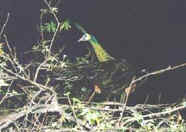Green Peafowl(Pavo muticus)
Habitat: mountain forests in low latitude of tropical and sub-tropical forests, bamboo woods and bushes.
Feeding habits: get food with its bill or peck after scratching with claws.
 Food: leaves, flowers, fruits of vegetations and insects. Food: leaves, flowers, fruits of vegetations and insects.
Size: the largest pheasant bird. The body length of a male is 2.3 m and a female, 1 m. Weight: 7000-8000 g.
Habits: they often hang around on the ground to seek for food during daytime and rest on trees during the night. Green peafowl build their nests and produce their eggs in hiding bushes. During the mating period, male green peafowl often display their tails to show their beautiful feathers, i.e. the so-called "a peacock in its pride". At the same time, the male utters sounds like "ah, wu, ah, wu". The covering feathers in the tail of a male peafowl are well developed, the number of which can reach more than 100 pieces. Besides, there are also eye-shaped stripes of all kinds of colors, including purple, yellow, blue, green etc. This special show is only found in peafowl.
There are all together 3 species of peafowl in the world, i.e. the green peafowl, the blue peafowl and the Congo peafowl. Blue peafowl is quite similar with green peafowl; only that the color of their tails is mainly blue and the feather crest of blue peafowl is like a bat. The history for people to raise blue peafowl is far and long and their number in zoos and raising farms also takes the lead. They form the variation specie of white peafowl too.
Category: Ave, Galliformes, Phasianidae
Distribution: South and Middle Yunnan.
Level of protection: Class II key state protection animal of China
 
|